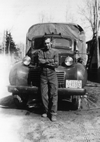5. Beyond the Grave
SEVERAL WEEKS LATER, Serafino was working with a group of men in a harvested field, threshing wheat for the winter while gathering tips about traveling to America. He didn’t need to look far for a diversity of opinions on the matter. About half the people who sailed from Italy to the United States in those days eventually returned to Italy. Some returned triumphantly with their wages. Others, like Vincenzo, returned disillusioned or lonely or both.
“Sonuvabitch!” Vincenzo swatted his donkey while plowing an adjacent field. “Sonuvabitch!” he cursed louder above the complaining brays.
It was the first English word that Serafino ever learned. “Watch this,” he winked at the men around him. “Ay, Vincenzo!” Serafino hollered across the field, cupping his mouth like a megaphone and egging on his irate friend. “What’s it like in A-me-ri-ca?”
“Money!” Vincenzo spit and sneered for everyone in the fields to hear. “It’s all about the money!”
The group of men laughed, but Serafino saved his money for three and a half years, tending the vineyards around Farindola and selling his wine. Vincenzo saved his money, too, for he had promised to accompany Serafino and to retrace the path of his father through eastern Pennsylvania. When the two accumulated enough money to pay for their roundtrip passages, they persuaded five other men from the village to join them.
“Promise me you’ll come home,” Angelade begged Serafino on his day of departure.
“Of course, I’ll come home, Mama.”
“I don’t want to lose you, too,” she buried her face in his warm embrace.
“You won’t lose me, Mama. Don’t worry. This is something I have to do for Papa.”
Serafino and his companions boarded the SS. Il Piemonte in Naples in May 1906. At 20, Serafino was the youngest. At 46, Vincenzo was the oldest.
Upon their arrival in New York City 23 days later, the seven men split off in different but interconnected directions. Just one of the men remained in the hub of New York City, joining the previous migrants from Farindola already there. Serafino and Vincenzo headed north to Harrison, New York, where a distant cousin would share tips about rail routes, coroner’s offices, and churches. The other four men traveled south to Philadelphia, where they would ask others from Farindola for ideas about finding the grave and await the arrival of Serafino and Vincenzo. The network of Farindola migrants would track the progress of the two men from state to state, hoping to secure their safety on an unpleasant quest while guiding them toward people who might know something about the final resting place of Nicola. It was a durable web of communication and consolation constructed by seven men who had arrived in an otherwise alien land.
But as with any network, it could tie together only so many loose ends. In all of their searches, Serafino and Vincenzo found no one who could pinpoint an exact location of the body. Nor did they find any death record for Nicola at any government office or church.
“Your father must have been buried in a pauper’s grave,” the most knowledgeable authorities in Pennsylvania told Serafino.
“But who buried him?” he pleaded, struggling to understand.
“It could’ve been anyone, maybe someone else who was riding the rails four years ago. Whoever it was could be long gone by now. But the grave must be somewhere near White Haven. It’s a small town where two rail routes converge along the Lehigh River.”
Serafino turned to look into the eyes of Vincenzo, who then dropped his forehead.
It was a bitter harvest for Serafino. He suspected that the explanation from the authorities was a generous one. “Maybe the body was never buried at all,” he speculated, wincing at the thought of what fate might have befallen his father’s scattered remains in the wild. “What good is it to torment myself?” he fought to arrest his imagination, telling himself that he had done his best. But his mind could not console his heart. Nor could he alleviate the sting of failure. And it only intensified his grief to wonder if he had poured years of sweat and heartache onto the barren soil of a misguided hope.
By piecing together the bits of information gleaned from those who had helped him in his improbable pursuit, Serafino could pinpoint only a date. He concluded that his father must have died and disappeared on July 2, 1902.
The search was over. Serafino and Vincenzo returned to New York in the late summer of 1906 and boarded a steamship home to Farindola. While sailing back across the Atlantic, Serafino had several days for contemplation and—at last—mourning. At some point along the voyage, as he pondered the infinite expanse of ocean all around him and allowed its gusty winds to stroke his face, the 20-year-old man realized that preserving a concrete connection to his father was not the only way to pay him proper tribute. Instead, Serafino decided, he would have to find some other way to keep the spirit of his father alive, to give him the respect and dignity he deserved, and to make sure that he was not—and never would be—some kind of forgotten soul.
